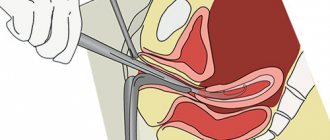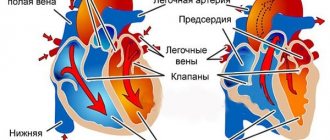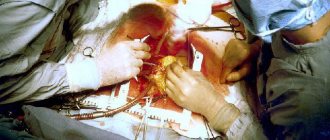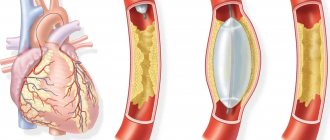A procedure such as uterine curettage is always a serious stress for a woman and a test for her body.
This is why bleeding is absolutely normal after this procedure. But you shouldn’t take it lightly either. After all, a woman’s body requires serious and long-term recovery after it.
That is why a woman should know what is normal after curettage, and when urgent medical intervention is required.
How does the body recover after curettage? How many days can it bleed? Prevention measures and symptoms of complications. Read more...
Recovery after cleaning the uterine cavity
Generally speaking, uterine curettage does not globally affect the functioning of a woman’s body; it is rather a psychological problem. Yes, of course, there are complications and difficulties during recovery, but all of these can be solved and with the proper quality of the procedure, the female body recovers quickly.
However, it should be remembered that after curettage the uterus is open, very vulnerable and is a bleeding wound of a fairly large size, because a whole layer of functional endometrium was removed from it:
- This condition is akin to what happens at the end of the menstrual cycle, that is, the endometrium peels off and leaves the uterine cavity.
- That's why you shouldn't be afraid of this procedure, because every woman experiences a similar condition every month.
If everything went well, then after the operation the woman may be discharged the next day, or may be offered to stay for another 2-3 days.
At the same time, she is prescribed anti-inflammatory, painkillers and hormonal drugs. She can easily take all this at home on her own. Hormonal ointments and suppositories are often used as additional treatment.
Attention! It is recommended to spend the first day after surgery lying in bed so as not to provoke even more bleeding. In the room, pain should stop after 2-3 days, and before that you need to take painkillers.
It is forbidden to have sex for a month after the operation . And after this time, you should strictly protect yourself. Pregnancy in this situation can only worsen the woman’s condition.
What is uterine curettage and what are the features of the procedure is described in the video:
The main differences between pathology and normal menstruation
Normal menstruation and bleeding caused by any disturbances in the female reproductive system differ in several ways:
- Cyclicity - menstruation begins regularly, at regular intervals.
- The amount of blood released - during menstruation, bleeding is heavy in the first 2 - 3 days, then subsides.
- Age - regular menstruation begins during puberty and ends during menopause; if bleeding occurs before or after this age, we should talk about pathology.
- Pain syndrome – periods are much less painful.
To learn how to count the menstrual cycle and its normal duration, watch this video:
How many days does the bleeding last?
The curettage process is a minor operation performed under general anesthesia in a hospital setting.
This removes the layer of mucous membrane that lines the inside of the uterus (endometrium). That is why after this operation there are often heavy and prolonged bleeding, pain in the lower abdomen and other unpleasant symptoms.
Almost all women who have undergone this procedure encounter this, and that is why it is very important to know what duration and intensity of bleeding is normal, and when to see a doctor.
Among other things, the reason for curettage plays a role here, for example:
- After an abortion, moderate bleeding lasting from 3 to days is considered normal, while spotting can last from 7 to 10 days. If the bleeding does not stop after 2 weeks, you should consult a doctor.
- If curettage is performed for a missed abortion , then the symptoms will be somewhat different. It is believed that after such a procedure, the discharge should be insignificant and last no more than 3-4 days. Blood loss should be significantly less than after a medical abortion.
- If curettage was carried out for diagnostic purposes , then heavy discharge is considered normal, lasting about 6–7 days, after which it should decrease and stop completely within 14 days.
The concept of scraping, types
The uterus is a muscular organ that resembles a pear. It is in it that the fetus “lives” and develops until birth. The inner wall of the reproductive organ is protected by the endometrium, which changes regularly. If conception does not occur, the endometrium is shed and then leaves the body along with menstruation.
Curettage is the mechanical removal of the endometrium, after which it grows again. The procedure is performed using 2 methods:
- Usually.
- Apart.
In gynecological medicine, the most common procedure is considered to be RDV, that is, separate curettage. During the operation, the upper part of the lining of the uterus is scraped with a special instrument. The doctor sends the extracted tissues for histological examination.
Conventional or hysteroscopic cleaning is carried out under the control of a hysteroscope. The doctor watches as the endometrium is removed. After diagnosis, the doctor chooses a cleaning method, depending on the pathology.
Operations are indicated in the following cases:
- Miscarriages or abortions;
- Diseases of the endometrium or uterus;
- Frozen pregnancy;
- Cycle failures.
Any major operation harms the body. A woman needs time to recover; diagnostic curettage is no exception. There is no need to worry only if menstruation proceeds as usual. A delay of several days is a reason to contact a gynecologist. After curettage, periods should be light, and they begin on days 28-36 of the cycle.
In cases where the discharge is abundant or scanty, and also has an unpleasant odor, there is a violation. Abortive curettage is a serious surgical intervention. Typically, menstruation begins after 4-7 weeks. If this does not happen, you should definitely consult a specialist. After separate curettage, the cycle returns to normal within 3 months. Sometimes there is pain that can be dulled with painkillers.
What complications can there be?
Curettage is a low-risk operation that rarely causes complications and is successful in most cases. But still, curettage carries some risk and complications are sometimes possible.
This:
- Perforation (puncture) of the uterus occurs when the doctor inadvertently pierces or punctures the uterus with an instrument. In this case, suturing is necessary.
- Cervical spasm occurs when a lot of blood has accumulated inside it.
- An increase in temperature after the procedure indicates the presence of an inflammatory process. Often a temperature appears when an infection has been introduced into the cavity.
- Violation of the growth layer of the endometrium always occurs through the fault of doctors. The complication is considered very serious, since the endometrium may not recover at all.
- Incomplete removal of the fetus , placenta or other formation for which the operation was performed. This complication requires repeated curettage and a longer recovery.
- A tear in the cervix is the result of the surgeon’s negligence. Minor tears usually heal on their own, but larger ones require stitches.
Before undergoing such a complex procedure as curettage, try to find a really good doctor to avoid negative consequences and repeated curettage.
Consequences for the female body
If the operation is performed by an experienced doctor, complications are not observed after the procedure. During cleaning, the top layer of the uterine mucosa is removed, which soon grows again, and its remains are excreted with the blood. Sometimes complications arise after curettage; the reasons for this may include:
- Too rough cleaning - as a result of such exposure, the endometrial sprouts are damaged and cannot recover, which causes infertility.
- Damage by the instrument - if the impact site is too large, the uterus is sutured. After perforation, menstruation returns to normal after 3-6 months.
- Inflammation - improper use of antiseptics and lack of antibiotic treatment leads to the development of an inflammatory process, which is accompanied by high fever.
- The accumulation of blood in the uterus - because of this, the risks of infection increase significantly.
- Neck tears - sometimes the instrument slips, causing tears. If they are minor, the damage will heal. In other cases, sutures are required.
Every woman should be prepared for such consequences. Delays are most often explained by hormonal and ovarian imbalances. If after cleaning there is a high temperature, pain, heavy bleeding and other unusual symptoms, the woman should visit a doctor.
Doctors' recommendations for recovery
General recommendations:
- Abstinence from sexual activity for at least 30 days to avoid infectious diseases and complications associated with them. In addition, during this period it is not desirable for male prostaglandins to enter the uterus, which cause its contraction.
- Over the next 6 months, it is advisable to use a condom to prevent pregnancy.
- For two months you should not take a bath, visit a pool or swim in bodies of water.
- During menstruation, you should not use tampons so that infection does not enter the uterine cavity and the inflammatory process does not begin.
- For six months, you should limit physical activity as much as possible.
Attention! It is not recommended to use any other means of contraception other than condoms for 6 months after curettage.
Recommendations for taking medications:
- If you are prescribed antibiotics, take them strictly according to the regimen recommended by your doctor. This applies to the time of administration, dosage and name of the antibiotic.
- It is very undesirable to drink alcohol during the recovery period. And while taking antibiotics, this is completely unacceptable.
- In addition to antibiotics, painkillers and enzymes are prescribed without fail; the latter are used to prevent adhesions.
During the recovery period, it is necessary to undergo several courses of physiotherapeutic procedures.
Recommended physiotherapeutic procedures:
- EHF therapy (irradiation with electromagnetic waves). This procedure helps increase the body's resistance and is a prevention of endometritis.
- UT - ultrasound therapy is used to prevent the formation of adhesions.
- Infrared rays are used to reduce and prevent inflammatory processes.
When urgent help is needed
In some cases, bleeding after curettage becomes pathological. You need to contact a gynecologist as soon as possible in the following cases:
- body temperature increased;
- the woman’s condition sharply deteriorated, severe weakness, dizziness, and fainting appeared;
- the discharge has a strong odor and the color of meat slop (this indicates the presence of infection);
- the bleeding stopped flowing two days after the operation, abdominal pain appeared (perhaps blood clots had formed in the uterus);
- bleeding is profuse and lasts quite a long time;
- the discharge does not stop, although more than ten days have passed after the procedure;
- pain does not go away after taking pain medications.
The symptoms listed above in most cases indicate a serious pathology that requires medical attention.
«>
What if there is no blood?
This is a very serious symptom that should promptly consult a doctor. What does the absence of blood after curettage indicate?
Most likely, we are talking about a hematometer , especially if the absence of discharge is accompanied by sharp spasmodic pain in the lower abdomen.
Reference! What is a hematometra? This is an accumulation of blood inside the uterus. The main reason is the accumulation of blood clots in the uterine cavity and complete blockage of the cervical canal.
However, there may be other reasons such as:
- Congenital anomalies of the uterus of the cervical canal.
- Atresia (fusion) of the cervical canal or vagina.
- Pathological formations in the uterus or cervical canal.
- Cervical or endometrial cancer.
- A fragment of the fetus and placenta remaining in the uterus after a medical abortion.
- Spasm of the cervical canal.
- Poorly performed abortion or incomplete extraction of a frozen fetus.
What are the dangers of a hematometra?
This is a very dangerous phenomenon not only for the health, but also for the life of a woman.
If she did not consult a doctor in time and the necessary measures were not taken, this threatens:
- Purulent inflammation of the internal genital organs.
- Removal of the uterus and further infertility.
- Sepsis (blood granulation)
- Lethal.
Attention! If there is no bleeding after curettage of the uterus, consult a doctor immediately. Most likely you will have to undergo the procedure of evacuation of blood clots or repeated curettage.
Treatment
Fortunately, treating hematometra is not difficult:
- To do this, the patient is prescribed drugs that cause contraction of the uterus and evacuation of blood and blood clots.
- Painkillers are also prescribed.
- If drug therapy does not produce results, then the uterus is cleaned with a probe, and a course of antibiotics is prescribed at the same time.
It should be said that hematometra in the initial stages is painless or accompanied by minor cramping pain, which most women ignore. And completely in vain.
Important! Regardless of whether you have pain or not, the absence of discharge is a reason to immediately consult a doctor.
What is hematometra, how dangerous is this disease and how to treat it is described in the video:
Treatment after curettage
The doctor prescribes hemostatic drugs and drugs that contract the uterus. In some cases, some traditional medicine may be recommended. Herbal decoctions and infusions act no worse than drugs, have no contraindications and save money. In severe cases, antibiotics are prescribed, and a blood transfusion or repeated curettage may be necessary. In case of hormonal imbalances, consultation with an endocrinologist is required.
After surgery, a special diet is mandatory. The menu needs to include more products that have a positive effect on hematopoiesis. These include buckwheat, red meat, beef liver, and pomegranate. Bed rest or lack of physical activity is recommended (depending on the patient’s condition).
In what cases is it necessary to urgently consult a doctor?
Before carrying out curettage, it is very important not only to consult with a doctor, but also to find out information about all possible complications, pathological conditions after the procedure and their symptoms.
List of symptoms that require urgent medical attention:
- Excessive discharge after the procedure (the pad fills within 30 minutes or less). This may indicate that fragments of the fetus or placenta remain in the uterus and are preventing its contraction.
- The release of large clots in large quantities, which come out of the uterus along with blood. This indicates a poorly performed operation.
- If the discharge smells unpleasant, this is also a reason to consult a doctor. Most likely, an inflammatory process is taking place here.
- If the discharge has a dark, uncharacteristic color, this may also be a sign of an inflammatory process.
- An abrupt cessation of discharge or, conversely, an increase in its intensity.
- If the discharge does not stop within a month.
- If the discharge stops, and then there is a sudden resumption.
- Increase in body temperature above 38 degrees.
- Weakness, trembling, dizziness, loss of consciousness.
How does the procedure affect menstruation?
Recently, vacuum curettage has been most often used, since this method is the safest compared to manual scraping. When cleaning is done with a curette, it is possible that the uterine wall is injured and the muscle layer is broken, which can provoke the development of pelvioperitonitis. In medical practice, cases have been recorded when the procedure ended in an inflammatory process.
The uterus has three layers:
- serous;
- myometrium;
- endometrium.
In this case, the latter is divided into basal and functional. The basal one acts as an assistant to the second layer. It promotes its growth, that is, the renewal of each cycle. With the maturation and compaction of the functional layer, unhindered attachment of the fertilized egg to the uterine wall occurs, which has a beneficial effect on the development of the embryo in the future.
In the absence of sexual intercourse, desquamation and release of the functional layer of the endometrium is observed; in other words, menstruation begins. And the presence of blood, in turn, is explained by damage to small vessels as a result of rejection of the upper layer. Since they practically do not undergo spasms in the uterus, bleeding is observed for several days.
In gynecological cleansing, it is necessary to adhere to one simple rule: diagnostic curettage is carried out only before the onset of menstruation, which allows the functional layer to recover as before. If therapeutic cleaning is necessary, it is recommended to carry out the procedure only after the end of menstruation, that is, after the entry of the functional layer. Then even more of it is removed along with the tumor. With such manipulations, restoration of the endometrium in one cycle is impossible. In this case, it will take more time.
After the procedure, the woman will have scanty discharge for seven days. Bloody symptoms are observed for up to three days. There are few of them, they may have a brown tint, which indicates their imminent cessation.
It is important to remember that the presence of such a moment is necessary. If deviations occur, uterine spasm may occur, which prevents the contents from exiting out, and it remains in the uterine cavity
This condition can cause suppuration of a blood clot, which is accompanied by the following symptoms:
- pain in the lower abdomen;
- increase in body temperature up to 38 degrees;
- fatigue, weariness;
- headaches and dizziness;
- nausea, often accompanied by vomiting;
- state of drowsiness.
If the color changes to a green or yellowish tint, as well as the amount of contents released, you should urgently visit your doctor.
If the first week after curettage passes without deviations, and all the gynecologist’s instructions are followed, then critical days usually occur at 4-5 weeks.
Additional nuances of scraping
Preparation
Since the curettage procedure is an operation, the preparation for it will be appropriate.
Analyzes:
- General blood and urine analysis.
- Fluorography.
- Smear.
- Biochemical blood test (HIV, syphilis, blood group).
- Ultrasound examination (ultrasound) of the pelvic organs.
- Cardiogram.
Immediately before the operation it is recommended to eat and drink; the procedure must be carried out on an empty stomach.
In the morning before the procedure, you should take a shower, remove hair from the perineal area, and put on clean underwear.
You should also be prepared for the fact that you will have to spend several days in the hospital. Therefore, take with you a robe, slippers, a change of underwear, pajamas and other necessary accessories.
Reference! Ask your doctor in advance what medications you will need and buy them, especially for painkillers, and also ask about the symptoms of possible complications. Remember, you must be prepared for anything.
Recovery period
After curettage, until the integrity of the vessels is completely restored, the uterine cavity will bleed. It is considered normal if spotting after curettage lasts from 3 to 10 days. To relieve pressure in the uterus, during the first three to four days it is better for a woman to stay in bed, avoid physical activity, and not sit for a long time.
Discharge
For the first 5 days after the procedure, a woman may feel pain in the vagina and may be bothered by pain in the lower abdomen.
To relieve unpleasant symptoms in the first two days, a woman is recommended to apply an ice pack to her lower abdomen (for half an hour every two hours).
Discharge after curettage in the form of bloody clots should continue until the vessels damaged during the procedure are restored. Red clots normally turn brown after a few days, and by day 10 they turn yellow or whitish. The day of intervention is equal to the first day of the menstrual cycle, which means that normal menstruation should begin in 24-32 days.
In women after a frozen pregnancy or abortion, the onset of menstruation is delayed. If menstruation does not occur for more than 2 months, a woman should urgently consult a doctor.
Maintenance therapy
Relieving pain, preventing infection and possible complications is the task of the next, recovery stage.
During the recovery period, the doctor may prescribe the following drug therapy:
- Analgesic drugs (Ibuprofen, Analgin). Relieves pain, reduces discharge after curettage. In the first two days, the drug is prescribed three times a day. From the third day, the analgesic can be taken only at night.
- Antispasmodic drugs (No-spa). Antispasmodics cause smooth muscle contraction, and discharge after curettage does not accumulate in the uterine cavity.
- A course of antibacterial drugs Antibiotics after curettage are indicated for prophylactic purposes. To prevent the development of infection, gentle drugs are prescribed: Metronidazole, Cefixime, Cedex, Ceftazidime.
Metronidazole is most often prescribed as monotherapy, but in some cases it is used in combination with other antibiotics.
During the recovery period, decoctions of stinging nettle and oregano are prescribed to contract the uterus.
If by the tenth day the discharge after curettage does not decrease, the number of clots increases, and the pain persists, this is a reason to urgently consult a doctor. The opposite condition, when the discharge after cleansing is very scanty, is also dangerous and indicates the onset of a complication.
General recommendations
After the curettage procedure, a woman should abstain from sexual intercourse, not take a bath, not swim in bodies of water, and not visit the pool or sauna.
What else you can't do:
- Use vaginal suppositories, tablets, sprays without a doctor's prescription.
- Douche.
- Use any intimate hygiene products.
- Lift weights.
After two weeks, the woman should visit her doctor. By this time, the results of the histological examination will be known. The doctor may prescribe a control ultrasound. Based on the collected data, repeat curettage may be prescribed.
What should the discharge be like after curettage and how long does it last normally?
Discharge after cleaning the uterine cavity occurs like normal menstruation. Normally, it lasts about 10 days, at first it bleeds profusely, then more and more sparingly. Finally, there is brown discharge after curettage, which indicates the healing process of the uterus. Then it stops bleeding and begins to “smear” with a light color.
How long does the discharge last? The maximum bleeding period should not exceed 10 days while taking hemostatic drugs. The presence of clots in the first days is allowed, but the discharge after cleaning the uterus should not have an unpleasant odor. Yellow or green color of the discharge indicates pathology, the addition of a bacterial infection. If your body temperature increases, you should consult a doctor.
When is curettage performed?
The inner tissue of the uterine cavity is a mucous layer called the endometrium. For some reason, sometimes this fabric needs to be cleaned completely or partially. Such manipulations are carried out surgically using special medical instruments (see photo). This process refers to surgical intervention, and therefore has all the postoperative symptoms and carries a large burden on the body.
Curettage performs a therapeutic and diagnostic function and is used in the following cases:
- Thinning (hypoplasia) of the endometrium or thickening (hyperplasia).
- The presence or suspicion of a malignant or benign neoplasm, polyps, fibroids, fibroids (read about discharge after removal of uterine fibroids at the link).
- Inflammatory processes of uterine tissues.
- Endometritis, endometriosis.
- Pathologies of the cervix.
- Menstrual irregularities.
- Freezing of the embryo.
- Abortion.
- Completion of abortion due to unsuccessful pharmaceutical abortion or vacuum aspiration when the fetus was not completely removed.
- Often, endometrial particles are cut off for the purpose of hysteroscopy and separate diagnostic curettage (RDC). It is used to identify gynecological pathologies of the mucous membrane or cervical canal of the cervix.
- It is also used as a biopsy - the collection of tissue particles for examination for atypical cells.
In the article at the link you can find out on what day of the cycle the endometrial polyp is removed.











